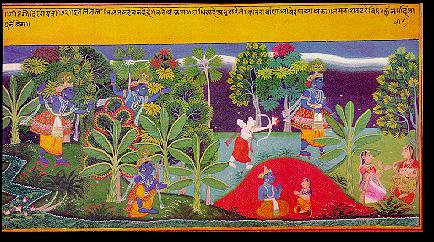Tweet

"Itastata... kunja ma haim jaine baitha."
"Pierced by the arrows of love
Madhava looks for Radha.
Repentant and remorseful He wanders
In the lonely thicket on the Jamuna."
The artist recreates this wandering lost repentant Krsna with remarkable fidelity and success. A disturbed nature with trees and plants falling on each other in disarray, a dark night with distant luminosity, and a flowing Jamuna provides the natural setting. Madhava is seen as many as four times in the painting. First in the left hand corner walking hurriedly, next as if flying out of the trees in mad anxiety, next seated remorseful with folded hands, and next lost, forlorn, and pierced by the arrows of Kama, the God of love. Significantly Kama is no longer hidden in distant trees. This is a powerful impish Kama who is taking particular delight in afflicting his divine victim. Radha and the sakhi sit in one corner, with Radha holding her necklace, suggesting that she binds Krsna to her heart.
The confusion of the trees, mango, palm, banana, sapta parni is highly structured and meticulously sketched. It is somewhat surprising that scholars have so far overlooked this treatment of nature in Indian miniatures. Comment has been restricted to stylistic distinctiveness and the formal elements of the use of brush, line, and shading. The formal technical aspects are undoubtedly the artistic tools of creative expression, but the power and depth of the tool lies in its ability to convey something beyond a surface meaning. The real achievement of the Mewari artist, as of the Assamese artist of a Gita-Govinda set, lies in this ability to relate nature and emotion in a manner to make the two integral to each other. The color supports the emotive states. The poet creates word pictures of color, sound, and movement. The artist creates aural and kinetic pictures through brush, line, and paint.

